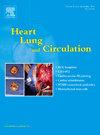Wire Cerclage Versus Rigid Plate Fixation: A Retrospective Cohort Study and Cost-Benefit Analysis on Method of Sternotomy Closure After Cardiac Surgery
IF 2.2
4区 医学
Q2 CARDIAC & CARDIOVASCULAR SYSTEMS
引用次数: 0
Abstract
Background
Despite increasing evidence demonstrating the merits of rigid plate fixation over wire cerclage for sternotomy closure, wire cerclage remains the predominant standard of care, largely because of the substantial cost of plating systems and the perceived lack of difference to outcomes.
Aim
This study aimed to compare the incidence of sternal complications between patients receiving rigid plate fixation vs wire cerclage and thereby assess the cost vs benefit of said sternal closure methods.
Methods
A retrospective cohort analysis was performed on patients who underwent open cardiac surgery at a single Australian tertiary centre between January 2019 and January 2023. Data were obtained from the Queensland Cardiac Outcomes Registry. The rate of readmissions for sternal complications were compared between those receiving wire cerclage sternal closure vs rigid plate fixation. Index admissions of each cohort were compared to assess secondary outcomes of hospital length of stay, intensive care unit length of stay, and admission costs, using marginal treatment effects analysis to adjust for differences in the two patient groups. Costs associated with each method of sternal closure were assessed, including those pertaining to readmissions.
Results
A total of 941 patients underwent sternotomy closure with wire cerclage and 67 patients received rigid plate fixation. Patients in the plate fixation group were at higher risk of sternal complications because of a higher body mass index (33 vs 29, p<0.001), bilateral internal mammary artery graft use (22.4% vs 6.9%, p<0.001), and rate of diabetes (37.7% vs 22.2%, p=0.007). Comparing index admissions, the use of rigid plate fixation was associated with a trend towards reduced hospital length of stay (12 vs 14 days) and intensive care unit length of stay (33 vs 45 hours), with similar total admission costs. There were 37 readmissions for sternal wound complications in the study period, all of which occurred in the wire cerclage group (incidence rate 3.9% vs 0%, p=0.17). Majority of readmissions were attributed to deep sternal wound infection (n=21). Each readmission was associated with an average hospital length of stay of 17 days and admission cost of $42,326 Australian dollars. Over the study period, the total cost of readmissions for sternal complications was $1,661,414 Australian dollars.
Conclusion
The use of rigid plate fixation compared with wire cerclage for sternotomy closure was associated with a strong trend towards reduced sternal wound complications, such that the higher initial costs of rigid plate fixation were offset by the substantial costs of said complications. Thus, an argument is made for considering rigid plate fixation as a first-line method of sternotomy closure, regardless of risk profile.
钢丝环扎与刚性钢板固定:心脏手术后胸骨切开术闭合方法的回顾性队列研究和成本-效益分析。
背景:尽管越来越多的证据表明刚性钢板固定优于金属丝环扎术用于胸骨切开术闭合,金属丝环扎术仍然是主要的护理标准,主要是因为金属丝环扎术的巨大成本和疗效的差异。目的:本研究旨在比较接受刚性钢板固定与钢丝环扎术患者胸骨并发症的发生率,从而评估上述胸骨闭合方法的成本与收益。方法:对2019年1月至2023年1月在澳大利亚某三级中心接受心脏直视手术的患者进行回顾性队列分析。数据来自昆士兰心脏结局登记处。我们比较了钢丝环扣胸骨闭合组和刚性钢板固定组胸骨并发症的再入院率。对每个队列的指数入院进行比较,以评估住院时间、重症监护病房住院时间和入院费用的次要结局,使用边际治疗效果分析来调整两组患者的差异。评估了每种胸骨闭合方法的相关费用,包括与再次入院有关的费用。结果:941例患者行胸骨切开闭合加钢丝环扎术,67例患者行刚性钢板固定。由于较高的体重指数,钢丝环扎组患者胸骨并发症的风险更高(33 vs 29)。结论:与钢丝环扎进行胸骨切开术相比,使用刚性钢板固定具有减少胸骨伤口并发症的强烈趋势,因此刚性钢板固定的较高初始成本被所述并发症的大量成本所抵消。因此,无论风险如何,我们都有理由考虑将刚性钢板固定作为胸骨切开术的一线治疗方法。
本文章由计算机程序翻译,如有差异,请以英文原文为准。
求助全文
约1分钟内获得全文
求助全文
来源期刊

Heart, Lung and Circulation
CARDIAC & CARDIOVASCULAR SYSTEMS-
CiteScore
4.50
自引率
3.80%
发文量
912
审稿时长
11.9 weeks
期刊介绍:
Heart, Lung and Circulation publishes articles integrating clinical and research activities in the fields of basic cardiovascular science, clinical cardiology and cardiac surgery, with a focus on emerging issues in cardiovascular disease. The journal promotes multidisciplinary dialogue between cardiologists, cardiothoracic surgeons, cardio-pulmonary physicians and cardiovascular scientists.
 求助内容:
求助内容: 应助结果提醒方式:
应助结果提醒方式:


